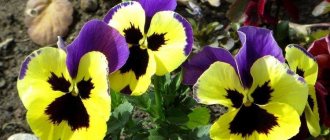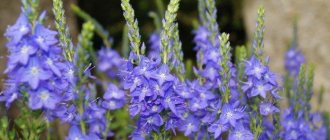Fragrant violet is located in fields and meadows. Gardeners have learned to grow it at home, in gardens, front gardens and vegetable gardens. Fragrant violet flowers appear inflorescences earlier than other crops.
Author of the article
Anna Dmitrieva
Gardener with 15 years of experience.
Therefore, designers include it in the list of garden decorations. The flowers have a bluish tint. The plant looks good alone or in a group. If you take care of the crop, it will delight you with its aroma and flowering for half the summer.
general information
Most violets are perennials, but they are most often grown in the garden as annuals and biennials. This is due to the fact that they grow and lose their decorative effect. Large ovoid or heart-shaped leaves are collected in a basal rosette.
In their natural environment, violets prefer partial shade and open, damp places, regardless of whether they grow in Europe or Africa. Violet flowers are single, with large lower petals, and can be of different shapes and shades. The average height of the bushes is up to 30 cm, but there are also very dwarf varieties.
Violets bloom in spring or summer, depending on the variety. They feel great between trees, near conifers and among bushes. They can also be used to decorate rock gardens, and can also be planted in containers and flowerpots.
Photo: valesad.ru
Possible problems in growing
The fragrant flower practically does not cause problems, resisting unfavorable factors to the last. This makes it one of the leaders in survivability.
Diseases
Garden azalea - planting and care in open ground
Among the infectious diseases of garden violets are:
- rust;
- blackleg;
- gray and root rot;
- powdery mildew;
- spotting.
Note! Unnatural plaque and spots on the leaves are a signal to take urgent action.
It is best to urgently remove the affected plants, or try to save them by treating them with a specialized preparation: “Topaz”, “Fundazol”, “Fitosporin”. "Fitolavin", etc. The intensity of watering the violet should be reduced during this time.
Pests
Nibbled edges of leaves are a symptom of violet pearl and cutworm infestation. They are treated with tobacco infusion or karbofos.
Common pests such as thrips, slugs, aphids, and spider mites are also found on garden violets. Treatment with specialized insecticides, as well as spraying the planting with an ash solution, helps against them.
Other problems
Wilting and spots on the leaves are a signal that the plant is not feeling well in that area.
Probable reasons:
- too dark;
- too hot;
- excessive watering;
- lack of nutrients.
Advice! You can try replanting it in a more illuminated area, feeding it, and adjusting the watering regime.
Common mistakes when growing
The shallow root system means that loosening can easily damage the violet. However, loose soil is good for it. This is achieved by mulching and structuring the soil.
The second common mistake is thickening. Plants should be 15-20 cm apart from each other.
Street violet, white or another color, is an excellent purchase for a garden, ridge, or flower bed. It is grown in hanging containers and flowerpots. Everywhere her cute and bright flowers look appropriate and extremely aesthetically pleasing.
Types of violets
The choice of violets is so huge that the number of their species has long exceeded 500. But several of them are especially interesting for floriculture!
Fragrant violet
This is a perennial with the same purple, pink or white buds. Its features are heart-shaped leaves, simple or double flowers and a bright aroma due to the high content of essential oils.
Photo: flo.discus-club.ru
Graceful violet
An elegant appearance with serrated textured leaves and large flowers up to 4 cm each. Graceful violets grow best in partial shade, bloom until autumn, but require nutritious soil.
Photo: botanichka.ru
Horned violet
Another perennial, but with a more varied palette of shades. For example, there are even yellow flowers. In addition, they are larger, up to 5 cm in diameter, and have a small horn on the back.
Photo: sad-fialok.ru
Labrador violet
A fragrant compact species up to a maximum height of 10 cm. The leaves of the Labrador violet are bronze or purple, and the buds are deep pink.
Photo: marusin-sad.com
Altai violet
An ideal variety for propagation in the difficult conditions of Siberia. In addition, it is found in nature on the territory of Kazakhstan. Single buds up to 3 cm bloom on long peduncles.
Photo: altzapovednik.ru
Tricolor violet
A field species whose flowers are painted in three colors at once - purple, lilac and yellow. Different varieties can be grown as annuals or perennials.
Photo: vikings-warofclans.ru
Dog violet
Its flowers are very interestingly hidden in the axils of the leaves. It blooms towards the end of spring with medium-sized flowers of all shades of white, blue and lilac. This is a more spreading species.
Photo: fotokto.ru
Wittrock violet
A huge and diverse category of decorative hybrids with an endless choice of shades, shapes and sizes. The showy spotted varieties are especially interesting.
Photo: loudwallpapers.com
Loosestrife (50 photos): types, planting and care in open ground
Garden perennial Labrador violet
Compact, low (5-10 cm) bushes with rounded heart-shaped leaves and delicate, medium-sized flowers rising above the foliage. The color of the leaves is bronze or dark purple, especially bright in spring and early summer. The color of the flowers is pink-carmine. Flowering - late May - June.
Garden perennial Labrador violet grows well in full sun, but can tolerate partial shade. Very cold-resistant. Loves fertile, moderately moist soil.
Propagated only by seeds, which are sown in the ground in the fall or from March to May in boxes for seedlings. Seeds can germinate for quite a long time - within 1-15 months. Under favorable conditions, plants can self-sow.
Usage. In rockeries, in the foreground of mixborders, under sparse bushes, in tree trunks.
Variety "Purpurea" - dark purple flowers.
Caring for violets
It is enough to plant a violet correctly once and then admire its beauty for years. It will only be necessary to plant and thin out the flowering carpet in time.
Temperature and lighting
Most varieties for growing in the garden are resistant to cold and frost. But they tolerate heat worse and may stop blooming in direct sunlight and at temperatures above +30 degrees. Lighting preferences depend on the specific variety.
Photo: domashniecvety.ru
Watering
Violets cannot be flooded, so carefully monitor the condition of the soil. For irrigation, you can use slightly acidified water. In hot weather, spray in the morning and evening. The main thing is that the water for all procedures is warm.
Photo: youtube.com
The soil
Violets definitely need loose and light soil that retains moisture well, but does not turn into a swamp. Therefore, be sure to use leavening agents such as vermiculite and sand. It is useful to sometimes add coal or ash. For planting in containers and flowerpots, use ready-made soil mixtures for violets with optimal acidity.
Photo: budgetstories.ru
Fertilizers and fertilizing
Violets need mineral fertilizers for flowering plants, which contain more potassium and phosphorus than nitrogen. We advise you to reduce the dosage relative to the manufacturer's recommendations for other colors. Do not use fresh organic matter because it causes burns.
Photo: aromesdeprovence.ru
Thinning
The thick carpet of violets must be thinned out, because otherwise it is a sure path to fungus and mold. Good air circulation is a must, especially on cool, humid days.
Photo: fotokto.ru
Wintering
With the onset of the first frosts, annual varieties are simply removed along with the root system. For perennials, it is necessary to cut off the flower stalks and all dry parts of the plant. If the winter is snowless, take care of light shelter. Violet reproduces well by self-sowing, so in the spring you can simply select the strongest seedlings.
Photo: lady.mail.ru
Castor bean (50 photos): types, care and planting in open ground
Preparing for winter
Garden hydrangea - planting and care in open ground
Annual fragrant varieties in the fall with the arrival of frost are completely removed from the flower beds. Perennials are left for the next year, and the third year they are completely removed, as they grow too much, losing their decorative effect.
In autumn, you need to remove dry parts of the plant and wilted flower stalks. Usually by this time the seed pods have already opened and scattered. No additional planting is required.
Under favorable natural conditions, spring violets will sprout on their own after winter. It will be possible to leave successful seedlings or use them for transplants.
Planting and propagation
Fresh seeds are planted directly into the ground in the fall, and then young shoots appear in the spring. You shouldn’t cultivate one plant for more than 3 years, so the next step is to divide the bush and propagate by cuttings.
If you want to better control the shape and size of the planting, plant the seedlings in containers. In this case, the seeds are sown 1-1.5 months before transplanting to a permanent place. After 1.5-2 weeks in warmth and humidity, but in the dark, seedlings will appear. When real leaves appear, start using fertilizers.
Before transplanting, gradually harden the seedlings by exposing them to air for a couple of hours. When the weather stabilizes, plant the healthiest seedlings with a large number of buds in the garden.
Photo: flowerglossary.com
Manchurian violet in the country
A perennial herbaceous plant from 6 to 20 cm in height, with a short rhizome and ovate-lanceolate leaves on long “winged” petioles.
The flowers are dark purple, 2.5-2.6 cm in diameter, rising above the leaves on long stalks. On one plant, from 8 to 14 flowers open simultaneously.
Blooms in May - June, abundant flowering, lasts for a month.
Growing conditions. Photophilous, cold-resistant. Prefers loose, nutritious, moderately moist soils. Propagated by seeds and division of clumps. Can produce abundant self-seeding.
Usage. It can be grown in rockeries, mixborders, as well as in gardens and parks on the edges along bushes and in open places, where it forms beautiful clumps. Manchurian violets are also widely used in the country, the main thing is to provide it with regular watering.
There are many varieties with different colors and sizes of flowers, as well as with double or variegated (hatched) flowers:
" Myo-Jin" - with purple flowers.
"Fuji Dawn" - with white-variegated leaves.
"Ebiche" - with pink flowers.
Interesting on the topic:
Momordica
Mar 5, 2022
Whose saffron is better: a unique spice from Imeretian...
Mar 4, 2022
Pests and diseases of violets
Leaf spotting on violets most often appears due to sunburn or improper spraying of the leaves. But if the spots quickly spread, become covered with plaque and change structure, this is a sure sign of a fungus.
It could be rust with red spots or powdery mildew with a white coating. Regardless of the type of fungal disease, there is only one treatment - remove the damaged parts of the plant and treat everything with fungicides.
Chlorosis occurs due to improper care, and in particular due to a lack of fertilizers. Due to damage to the roots due to improper transplantation and propagation, rot develops. All this can be avoided if you carefully follow agricultural practices.
The most common pest of violets is aphids, which in addition carry viruses and infections. But spraying with warm water and soapy water helps a lot. Also, spider mites, broad mites and cyclamen mites, as well as small sciarid mosquitoes, settle on violets. This requires mandatory treatment with professional insecticides.
White powdery coating may be a sign of mealybugs. With a small number of pests, they can be collected mechanically. For the rest, spraying with warm water and insecticides also helps.
The most dangerous pest is nematodes, which destroy the root system. They are very difficult to notice from the outside, but they leave wounds throughout the plant. Growths and bumps form on the roots, and gradually the plant rots. Violets affected by nematodes need to be removed quickly.
Photo: oldboy.icnet.ru
Muscari (50 photos): types, planting and care in open ground
Variegated violet in the garden
Forms a rosette of leaves up to 15 cm high, without shoots. The leaves are dense, kidney-shaped, 2.5-5 cm long, pubescent, dark green on top with silver veins, purple underneath.
Growing conditions. In nature it grows on dry slopes, steep cliffs, and dry steppes. In the garden, variegated violet requires bright, dry places with good drainage from fine crushed stone.
Use: Rockeries, alpine slides.
Varieties of variegated violets in the photo with descriptions:
"Syletta" - often sold under the name "cyclamenolifolia violet", has bright veins on the leaf blades.
Violet variety "Sylvia Hart" - with bright silvery veins on the leaves.
Violet – photo
Violets are so diverse in color and appearance of flowers that each flower bed is always unique in its own way. At the same time, they clearly retain the common features for which we love them!
Photo: pocvetam.ru Photo: domashniecvety.ru Photo: pinterest.ru
Photo: domashniecvety.ru
Photo: liveinternet.ru Photo: funart.pro
Photo: plantarium.ru Photo: fotostrana.ru
Photo: stihi.ru
Photo: plantarium.ru
Photo: baltachtan.ru
Photo: mrfilin.com
Photo: gemologyonline.com
Photo: liveinternet.ru
Photo: domashniecvety.ru
Photo: fotoload.ru
Photo: myproplants.com Photo: mrfilin.com Photo: sueveriya.com
Photo: m-sokolov.ru Photo: funart.pro
Photo: svoimirzvetov.ru Photo: zen.yandex.ru
Photo: zen.yandex.by
Photo: fragrantica.ru
Did you like the post? Subscribe to our channel in Yandex.Zen, it really helps us in our development!
Bush division and cuttings
Let's skip propagation using seeds and consider two methods based on the goal of vegetative propagation of a plant. For example, bush division rejuvenates the violet and prevents its death; cuttings allow you to propagate even one bush.
Dividing bushes
Dividing should be done in the spring - before flowering or in the summer - after flowering. Part of the bush is cut off with a knife or scoop, having previously cut off the remaining flowers, and planted in a new area, preferably in moist, well-draining soil, under the shade. Used for fragrant violets and pansies.
It is convenient to do this after rain. The plant takes root quickly. In the fall, the new bush will be able to bloom, and in the winter it will form a rhizome.
Cuttings
Most often, cuttings are taken from May to July - this is the most favorable period for this type of propagation. After the flowers become smaller and the bushes grow too much, you need to cut off the top shoots with 2-3 nodes. They need to be rooted 2 or 3 weeks after cutting. But they take root quite easily and by the end of summer - beginning of autumn you will be able to see the lovely blooming of violets. Also read our article about indoor violets “Uzambara violet - cultivation and care”
Similar articles:
Badan - photos of varieties, descriptions, tips for growing and caring
Silver cineraria - tips for growing and...
18 flowers similar to daisies - description and...
One species or a group of different species and varieties?
Over several centuries of active cultivation of violets by flower growers of the Old World and Russia
Many new species of this delicate plant have been bred: at the beginning of the 21st century, according to the Royal Horticultural Society (Great Britain), 21 species were used in gardening and landscape art.
Based on the main species, breeders continue to grow magnificent varieties and hybrids of violets, which differ in:
- Bright colors;
- Persistent odor;
- And big flowers.
The species of pansy (Viola Wittrock) has about 500 bred forms.
Also do not forget that white violet will look very beautiful and delicate in your gardens. The entire variety of violets used to decorate garden plots and public parks are commonly called garden violets.
The most popular and widespread among garden violets are hybrids
varieties of the species Viola Wittrock, called garden pansies by gardeners.
In addition, the following types are quite popular:
- F graceful;
- F. Khornataya;
- Chinese F (Manjurian);
- F. Labrador;
- F. Motley and some others.
Sister violet, or moth violet (Viola sororia syn. V. papilionacea)
Sister violet, or moth violet, grows best in partial shade on loose, fertile soil. The violet spreads, but rather weakly and not aggressively. There is one small nuance in agricultural technology: it has cleistogamous flowers, i.e. Fertilization occurs inside the unopened bud, and if they are not removed in time, the violet can turn into a malicious weed, scattering throughout the garden.
In addition to the main species with lilac flowers, there is also a white form, Viola sororia f. albiflora. Albiflora flowers are white with a blue throat, much larger than those of the main species. Flowering is long, the bushes are compact, slowly growing. There are bright hybrid varieties - Rubra - purple-red, and freckled varieties: Freckles - light with purple specks of varying sizes and intensities, Dak Freckles - light blue with even darker specks. Hungarian Beauty (Hungarian Beauty) appeared on sale Sister violet is stable and winter-hardy in central Russia. Partial shade or at least shading from taller plants is more suitable for her. If necessary, the jackets can be divided in early spring or autumn.
|
Fragrant violet (Viola odorata)
The fragrant violet is the most famous of the violets, but when planting it you need to remember that it is somewhat aggressive. It is recommended to plant this violet where there are no delicate tender plants nearby that it can displace, actively taking over the living space.
Fragrant violet has long been grown in the south of Europe to obtain essential oil, which has a steady demand in perfume production; special varieties 'Parma' and 'Victoria' were bred. Even in our country, at one time, plantations were created for their cultivation on the Black Sea coast of the Caucasus and in the Crimea. Violet essential oil is still used in very expensive perfumes.
Early on, quite a few garden varieties and forms with yellow, white and pink flowers were bred, the most famous and surviving to this day: Alba, Christmas, Czar, De Toulouse, Konigin Charlotte, Mrs. R. Barton, Red Charm.
| Fragrant violet Miracle Blue |
Today, nurseries are actively engaged in the search and restoration of old varieties and the selection of new ones. In particular, a new interesting variety series has recently appeared called Miracle - Miracle (V. odorata Miracle), characterized by more intense flowering and larger flower sizes than other fragrant violets: Miracle White (V. odorata Miracle White), Miracle Blue (V . odorata Miracle Blue), Miracle Red (V. odorata Miracle Red). The varieties are decent, they live and winter well in the conditions of the middle zone, they are quite worthy edging of mixborders.
| Fragrant violet Miracle Red |
Top ten most popular varieties
The most popular, both among experienced flower growers and novice collectors, are:
- The bride's bouquet;
- White Sun of the Desert;
- White Mustang;
- White Nights;
- White magic;
- Lady in White;
- Juliet;
- Cotton Candy;
- White angel;
- Your Grace.
The bride's bouquet
The bride's bouquet of Saintpaulias from the famous breeder Konstantin Morev blooms with large snow-white flowers with wavy petals and a creamy core, which gives the plant a pearly shine, creating a festive atmosphere.
White Sun of the Desert
Desert Sun White produces snow-white, medium-sized, smooth flowers that closely resemble wildflowers.
White mustang
A variety called White Mustang looks no less exotic. A velvety fan-shaped flower with a yellow core and blue spots in the design of dark green leaves looks especially delicate.
White Nights
Large bright blue semi-double stars with a bizarre coloration. This spectacular flower is called "White Nights" and is therefore part of the white violet subgroup. The rosette of Saintpaulia consists of several layers of dark green, velvety, cone-shaped leaves along the edge.
White magic
The White Magic variety is one of the brightest Saintpaulias with fringed, arrowroot flowers. It is one color - bright white. The rosette is variegated green with whitish veins.
Lady in White
Another unusual white variety is Lady in White. Huge, up to 8 centimeters in diameter, swollen white stars with wavy edges. The rose is small, graceful, light green.
Juliet
Along with plain white violets, varieties with multi-colored splashes are extremely popular. Juliet is one of these beauties.
Large, swollen stars are white with pink and purple flecks reminiscent of fantasy coloring. The petals are wavy, with a fan-shaped edge.
Cotton candy
The Candyfloss variety features abundant, snow-white, densely flowered roses with fluted petal edges. The rosette consists of wavy, toothed, medium green leaves.
White angel
This variety is somewhat different from other white varieties. Smooth, light blue, star-shaped flowers in a rosette of dark green, round leaves.
Your Mightiness
Your Lordship is a profusely blooming white rose with fan-shaped, spreading petals and scaly flowers. The abundance of dark green foliage makes the flower even more vibrant. It will decorate any collection, even of the most experienced and spoiled gardener.
Variety selection
Before purchasing a white violet, you need to wisely choose the variety of this plant. It is recommended to purchase the culture in a special store, since you can often find fakes on the market. When buying a flower, pay attention to the signs of the plant, which are given below.
Coloring and condition of leaves. The color should be light or dark green, there should be no spots. If the leaf petioles are stretched excessively, it is better not to buy this violet. After all, it was grown from a weak seedling, and there was no necessary lighting.
Socket. An overly tight rosette indicates that the plant has a disease.
Deadline for purchase. Professionals advise buying plants in the spring season, since in summer and winter the roots do not take root well at the new planting site.
It is worth noting that by purchasing 1 seedling, in the future it will be possible to grow more than one full-fledged house plant.
Description of varieties
Despite the large number of species and varieties of garden violets, they have a significant number of features:
- Most garden violets are low herbaceous plants or small shrubs;
- Many varieties have a basal rosette of leaves due to a shortened stem, but some are distinguished by the usual structure of the stem - so the alternation of leaves is clearly visible;
There are many garden violet flowers. - Whole leaves, less often slightly dissected, acquire an oval, heart-shaped or lobed shape. Some varieties have thick down on the leaves;
- Purple flowers are formed singly from the axils of the leaves on tall pedicels;
- The corolla necessarily consists of 5 petals, which in appearance resemble a moth. The lower and larger petal is located in the center and rests on two sepals, the next two petals, slightly smaller in size, sit on the sides of the lower one, and each has its own sepals. The top two petals are usually the smallest - the last sepal remains;
- The flowers often bear a special spur;
- The color scheme of the lilac corolla includes all possible shades of the rainbow.
Let's find out how to plant and care for the perennial garden violet. You can see photos from the Viola Biennale below.
Some varieties of viola are biennial.
To facilitate their classification, all varieties of forms of garden violets are divided according to distinctive features. One of the evaluation criteria is life expectancy
plants for which the following groups are distinguished:
- Annuals - grown from seeds, live for one year, are herbaceous plants. These include tricolor viola (can be grown as a biennial plant);
- Biennial - grown from seeds or cuttings, blooms in the second year, can be herbaceous or bushy. These are the tricolor viola (sometimes grown as an annual), hybrids of the Wittrock violet and many perennial violets, which growers prefer to grow as biennials;
- Perennials - grow as a small bush, propagate by both seeds and cuttings or by dividing the bush, can form large clumps due to canopy growth. The fragrant perennial garden violet has smaller buds, but blooms more profusely than the annual one. Representatives: Horned, Moth, Labrador violet.











